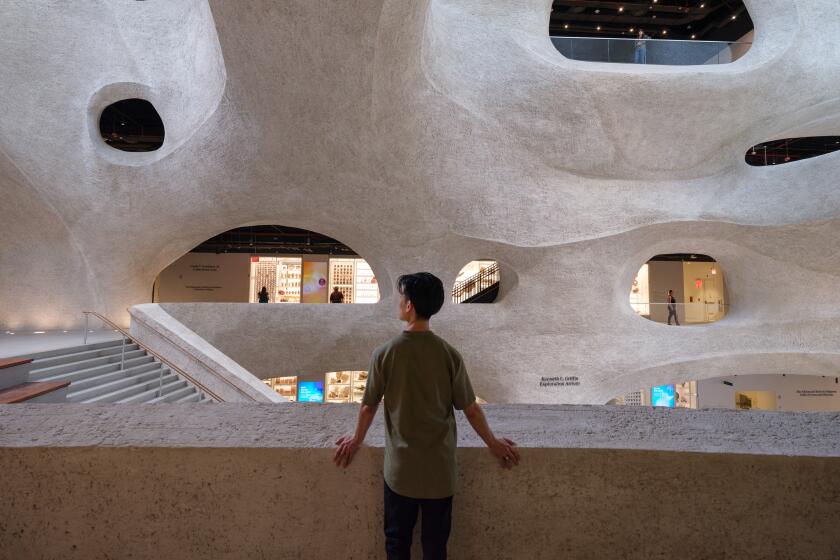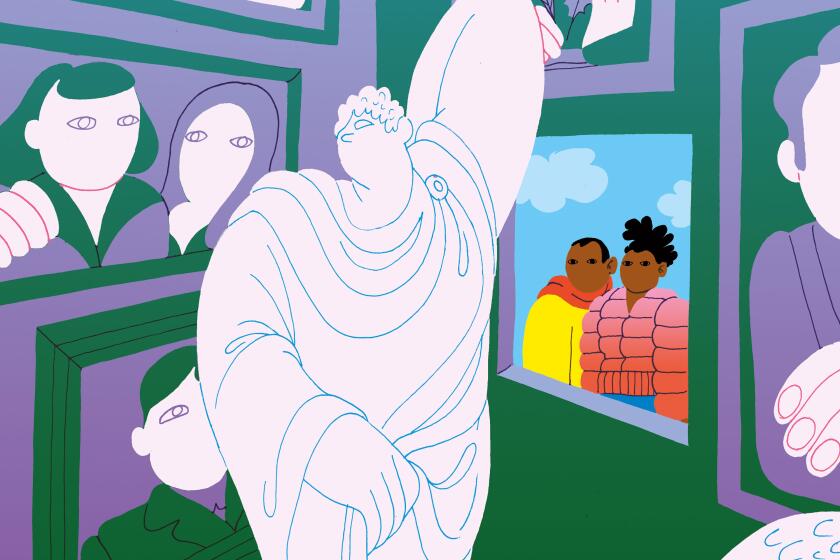A new study shows museum workers struggling. We need to evolve to meet the moment
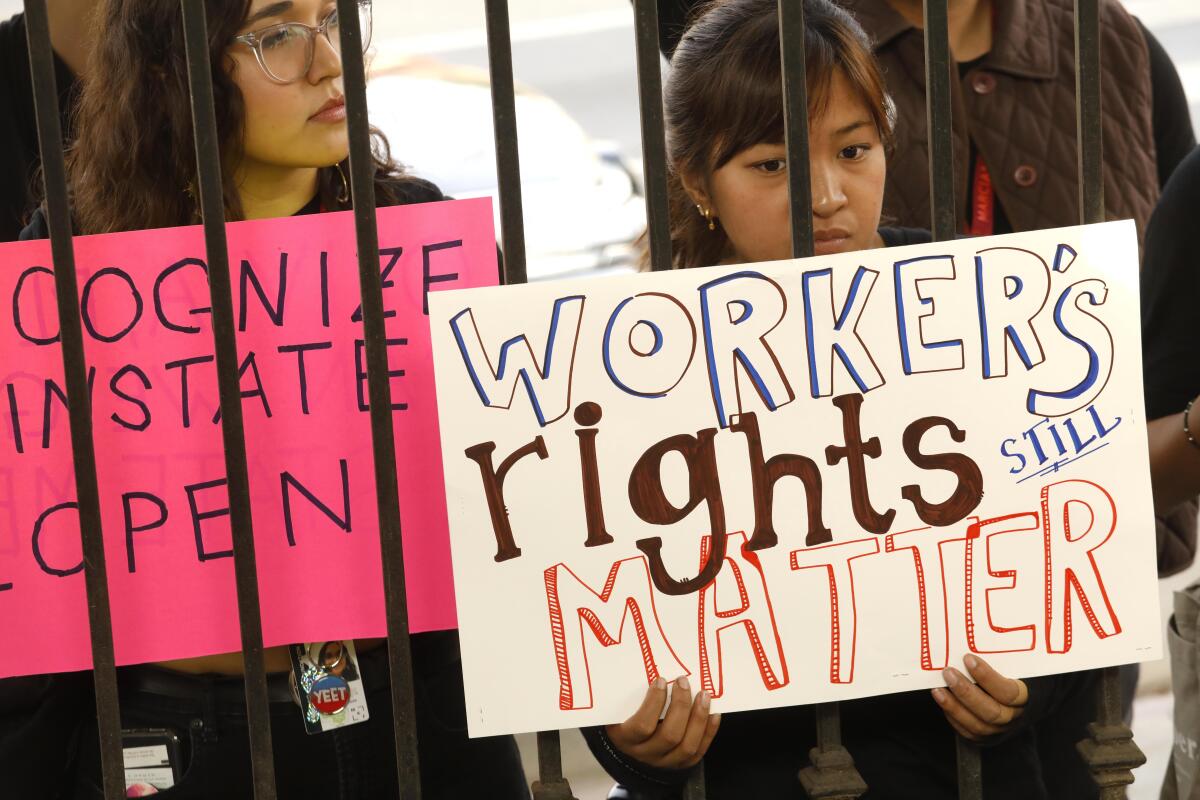
- Share via
The numbers are dispiriting: 68% of art museum workers have considered leaving the field, 74% cannot always cover basic living expenses, and it takes an average of 12 years before a worker receives a promotion. Turnover is high — art museums lost 30% of full-time employees hired between 2020 and 2022 — and rates were especially elevated among those making less than $50,000 a year.
Those are the findings of a new report, “Workplace Equity and Organizational Culture in U.S. Art Museums,” released Thursday morning by Museums Moving Forward (MMF), an advocacy group for equity in the museum sector. This is the first formal study from the group, which was co-founded in 2020 by Mia Locks, a former senior curator at the Museum of Contemporary Art Los Angeles, in collaboration with museum professionals from around the country. And it functions as a qualitative look at equity and workplace culture in museums, large and small, across the United States.
“Simply put, it is not enough to diversify the artists we are collecting or exhibiting; we must take better care of our people too,” the report’s authors write in the executive summary. “Ongoing union negotiations and social media outcries have made clear that the needs of workers are not being met. And, of course, the pandemic made a challenging situation even more dire, as the inequities have become ever more impossible to ignore.”
Museums espouse lots of high-minded ideas about the elevating power of culture, but as workplaces, they leave a lot — a lot — to be desired.
Numerous changes need to be made within. Unaddressed by the report is the external issue of patronage: Museums are largely funded by private philanthropists who are happy to put their names and hundreds of millions of dollars into fancy building projects but become scarce when it’s time to pay the workers.
Natural history museums have fraught histories. Studio Gang has designed a building that takes the concept out of the 19th century and brings it back to nature
As Christopher Bedford, then the director of the Baltimore Museum of Art (he’s now at the San Francisco Museum of Modern Art) told me in 2020: “Every museum director knows that it’s easier to raise money for the sexier initiatives than for the endowment intended to fund operations.”
If museums are going to stop — or at least slow — the staff burnout, that mind-set (along with funding structures) will have to change.
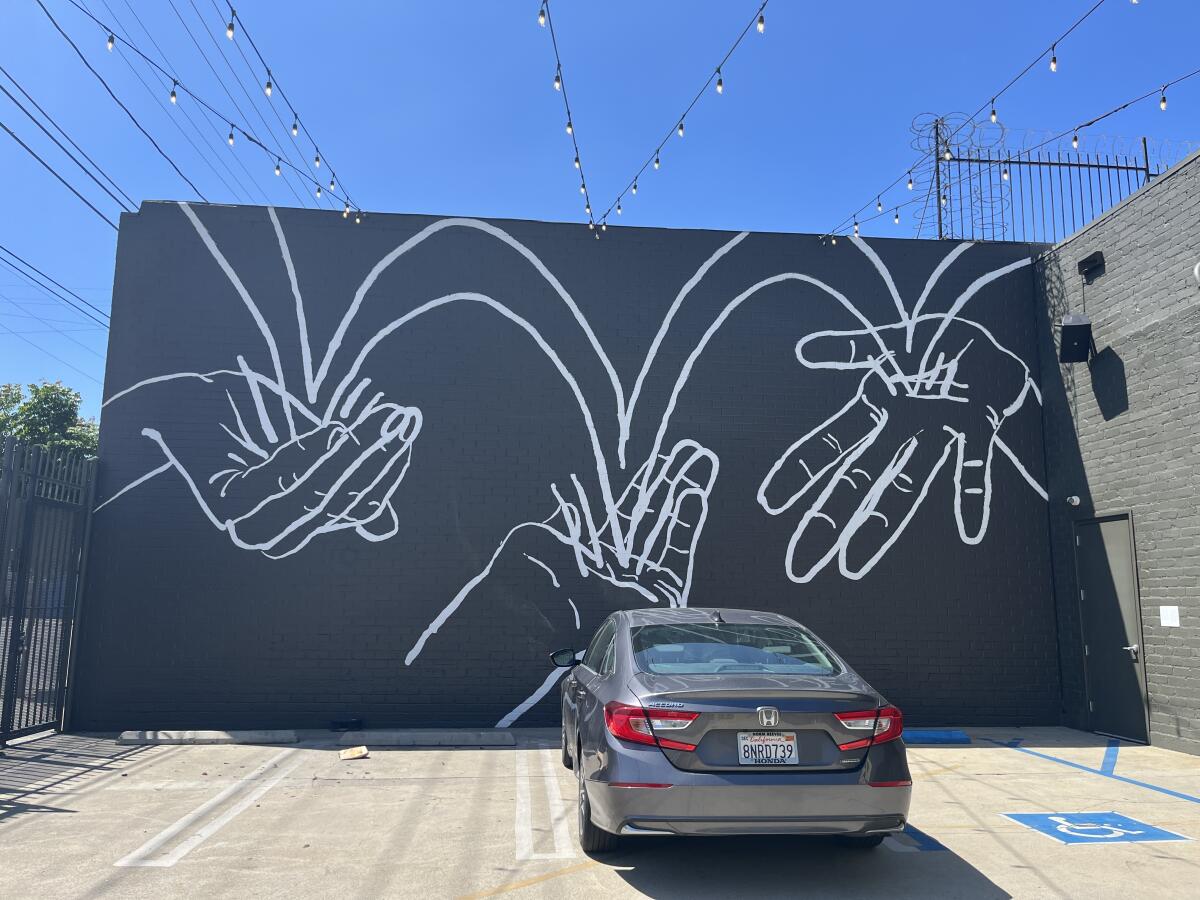
Much more than simply increasing diversity, the task ahead will consist of rethinking the very ways in which museums are governed.
Museums Moving Forward surveyed 1,933 staff members from more than 54 institutions. This included major museums such as SFMOMA and the Fine Arts Museums of San Francisco, the Brooklyn Museum in New York and the National Gallery of Art in Washington, D.C. In L.A., sadly, participation was weak, with only the Institute of Contemporary Art Los Angeles and LA Plaza de Cultura y Artes choosing to take part in the study.
“Workplace Equity” adds to a growing body of research on museum work life. The Assn. of Art Museum Directors and the American Alliance of Museums publish regular reports that detail museum demographics and outline some of the pressing issues facing museum leadership. But the MMF report is unique in that it surveys leadership and staff to see how these institutions are collectively approaching their missions.
In an analysis of what drives institutional decision-making, for example, 85% of executive leaders said it was the institution’s mission, vision and/or values that served as guide. But when staff were asked that same question, 70% responded that what guides decision-making is “the museum board’s priorities.”
You read it here first. A new executive director for the Museum of Contemporary Art will be announced, but an email to Times journalists is the real puzzler.
The report offers a laundry list of ways that institutions can improve conditions for their employees, including creating a workers “bill of rights,” offering more transparency around pay and implementing retention plans that include professional development. Another suggestion: “Provide more livable wages that can cover at least the cost of living.”
That last one is critical. Curatorial and other so-called intellectual leadership positions often require multiple advanced degrees, yet frequently pay entry level wages that qualify as low-income according to the Department of Housing and Urban Development. A salary survey published by the Assn. of Art Museum Directors in July shows that the median pay for a curatorial assistant is less than $51,000 a year; an assistant curator might earn almost $62,000 — salaries that qualify as low income in Los Angeles County.
Unionization campaigns and recent strikes across industries, including the museum field, have made the issue of a livable wage impossible to ignore. In Los Angeles, unionization campaigns have resulted in historic first contracts at MOCA and the Academy Museum of Motion Pictures over the last 16 months.
Last October, workers at the Philadelphia Art Museum went on strike over salaries and benefits. “You can’t eat prestige,” one museum worker told NPR. The museum and the labor union reached an agreement shortly thereafter.
A survey of art museum directors published last year by the research firm Ithaka S+R shows “providing a living wage” is a top priority among museum leaders, who are aware that diversity, recruitment and retention efforts rest on this. But as that report also notes, little has changed in terms of how budgets are allocated. Plus, labor already accounts for museums’ biggest operating expense at a time when there is a “heightened uncertainty” around funding.

That’s where funding structures come into play.
If the pandemic made anything evident, it’s the intense precarity experienced by public-facing workers at museums: guards, gallery attendants, visitors services associates, education workers and maintenance staff. (Basically everyone who keeps the place running day to day.) Not two weeks after the World Health Organization declared COVID-19 a pandemic in 2020, MOCA laid off 97 part-time employees; a month later, the Broad museum, across the street, laid off 130.
Greater public funding could provide some stability to museum workers.
The California African American Museum, for example, is funded by the state and staffers there are state employees, making them eligible for state benefits and pensions. None of the museum’s full-time staff was laid off during the pandemic.
The Utah senator described the Smithsonian’s proposed National Museum of the American Latino as divisive. More divisive: a society that erases Latinos
Hybrid public-private partnerships can likewise offer public-facing workers more security, as with the system devised by the Fine Arts Museums of San Francisco (FAMSF), which includes the Legion of Honor and the de Young. Like many museums, the FAMSF has a private foundation that raises money to cover exhibitions, acquisitions and curatorial and executive salaries. But it also receives critical public support from the city.
Instead of money, FAMSF gets full-time personnel. The public-facing workers at its museums are city employees and their wages are negotiated by the powerful Service Employees International Union. Like other public employees, they enjoy a range of benefits, including healthcare, paid leave and pensions. When the pandemic struck, no one was laid off. And if someone wants to seek an opportunity at another municipal agency or museum, their time at FAMSF counts toward their years of service.
L.A. museums such as the Los Angeles County Museum of Art receive funds from county coffers: $28 million in 2019, according to the museum’s most recent 990 tax forms. (As my former colleague Mike Boehm once noted in a story, the museum’s most reliable patrons are the county’s 10 million residents.) The funding, however, comes in the form of money, not personnel, which means public-facing employees do not enjoy the job security of their counterparts in San Francisco. When the museum shut down in the early days of the pandemic, LACMA laid off a small group of workers, even as it moved forward with a behemoth $750-million rebuilding plan.
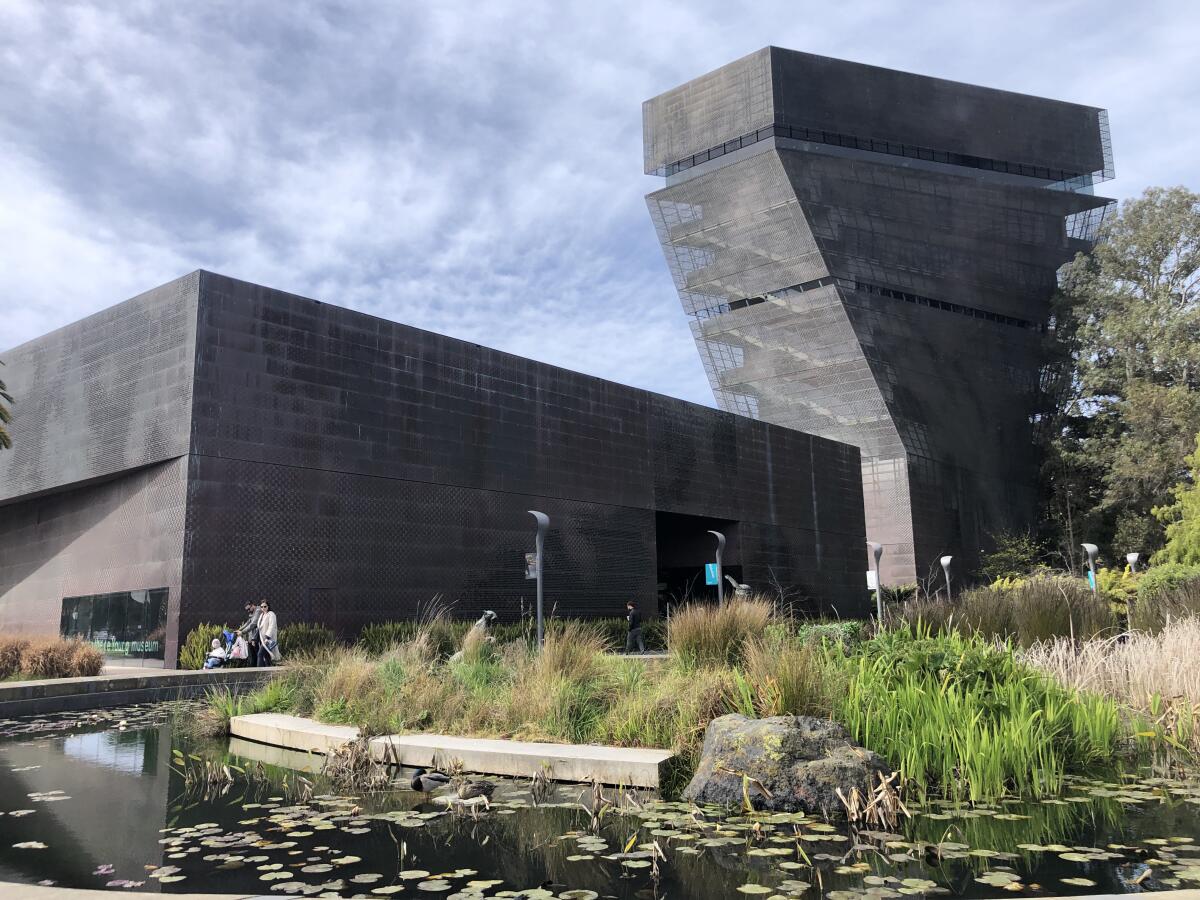
Where would additional funding come from to support museum workers? Certainly, we should press the private philanthropists, but a better idea might be to tax them.
In her 2022 book, “Museums and Wealth: The Politics of Contemporary Art Collection,” museum studies professor Nizan Shaked suggests levying a marginal tax on secondary art market sales to help fund museums. The price hikes on the resale of works can be stratospheric — think of every headline you’ve ever read about multimillion-dollar works being sold at auction. Now imagine a small tax on those sales going to a public museum fund. The idea, writes Shaked, “is to ensure those who profit from the field pay for its sustainability.”
Whatever the solutions, the problem is one museum boards and patrons can’t afford to put off for much longer. “Art museums are not struggling to find diverse workers,” states the Museums Moving Forward report, “they are struggling to retain them.”
Museums are often described as temples of culture, and as the reports notes, they could be “incredible spaces of collective growth.” But recent labor troubles have revealed institutions that feel less like temples and more like Amazon distribution centers. It’s time to invest — not just in buildings and objects but also in the people who care for them day in and day out.
More to Read
The biggest entertainment stories
Get our big stories about Hollywood, film, television, music, arts, culture and more right in your inbox as soon as they publish.
You may occasionally receive promotional content from the Los Angeles Times.
